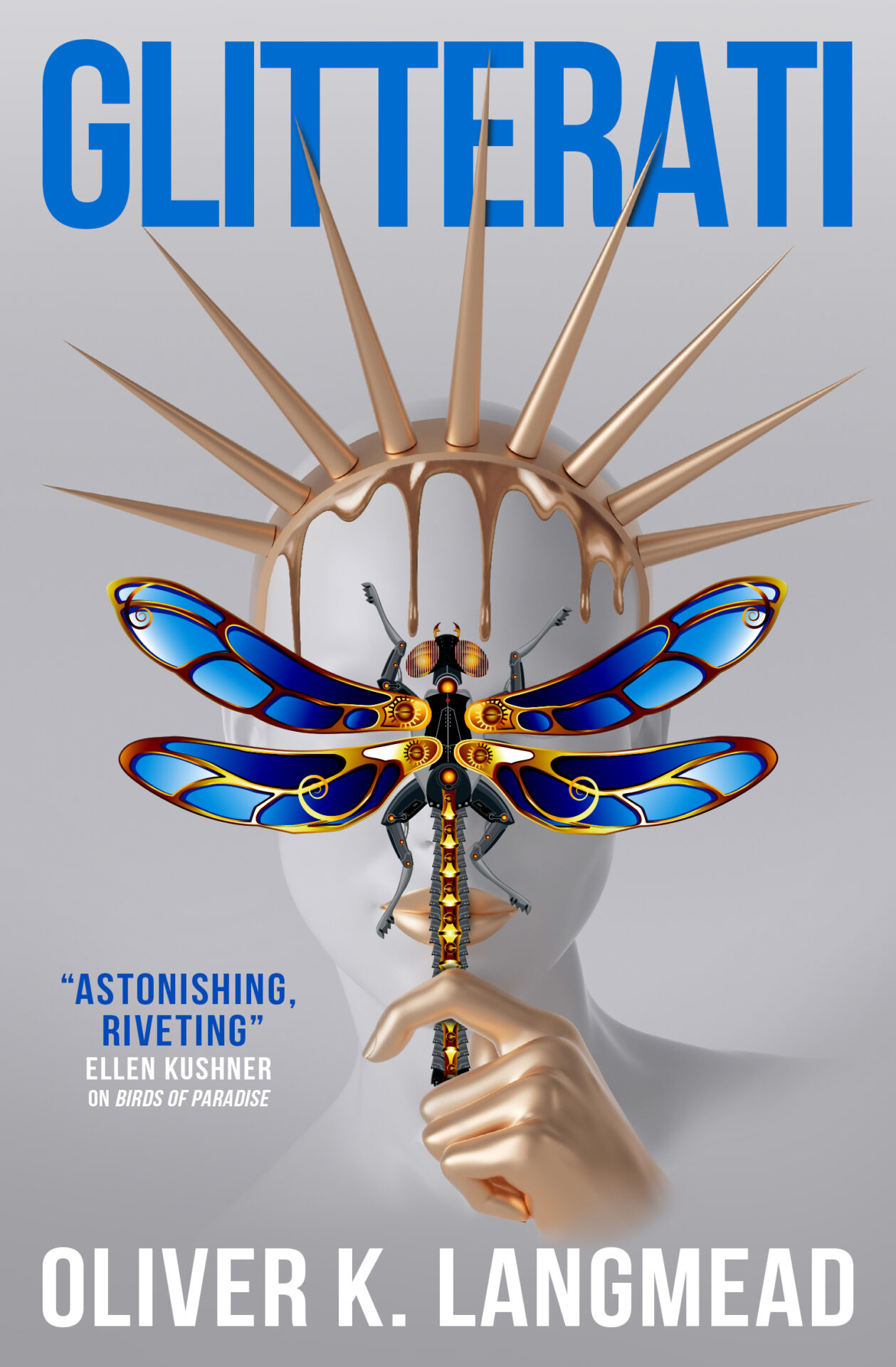
Oliver K. Langmead is joining us today to talk about his novel, Glitterati. Here’s the publisher’s description:
A Clockwork Orange and RuPaul’s Drag Race meet Eternal Sunshine of the Spotless Mind in this fabulous dystopian fable about fashion, family and feckless billionaires.
Simone is one of the Glitterati, the elite living lives of luxury and leisure. Slave to the ever-changing tides – and brutal judgements – of fashion, he is immaculate. To be anything else is to be unfashionable, and no one wants to be unfashionable, or even worse, ugly…
When Simone accidentally starts a new fashion with a nosebleed at a party, another Glitterati takes the credit. Soon their rivalry threatens to raze their opulent utopia to the ground, as no one knows how to be vicious like the beautiful ones.
Enter a world of the most fantastic costumes, grand palaces in the sky, the grandest parties known to mankind and the unbreakable rules of how to eat ice cream. A fabulous dystopian fable about fashion, family and the feckless billionaire class.
What’s Oliver’s favorite bit?

OLIVER K. LANGMEAD
Pos
HOSTILE ARCHITECTURE
Extremely wealthy people have such a strange relationship with their houses. Just look at all those empty mansions mouldering away in London; all those empty apartments overlooking Central Park in Manhattan, owned by oligarchs and billionaires who never visit them. They are monuments to excess.
Glitterati is a satire of the kind of extreme wealth that makes for empty mansions, and at its heart is a vast, uninhabited house that takes inspiration from them. It was so much fun to write:
“Simone’s father’s house squatted monstrously against the high hills, the product of a time when architectural fashions subscribed to labyrinthine excess. It had far too much of everything: too many windows; too many turrets; too many gargoyles; more wings than there were points on the compass… At its perimeter were endless gardens; entire forests with fairytale towers rising from their hearts; hedge mazes so grotesquely complex as to be unsolvable; a statuary corpus large enough to populate a small city. So, too, were there no end of chapels, and wells, and pool houses, and stables, and garages, and so many tennis courts that one might never have to play on the same court twice.”
There is something immensely satisfying about writing a deliberately excessive, exhaustive list. But of course, the labyrinthine mansion at heart of Glitterati is more than just excessive. It’s actively hostile towards its ultra-wealthy owner:
“Part of the problem with the house was that parts of it tended to shift around. Simone was aware that quite a few wings featured walls and staircases that would routinely change positions, giving the house a new layout every few hours or so. Worse, those walls and staircases only shifted when nobody was paying them attention, and were so cunningly disguised it made the shifting nearly impossible to anticipate. There were entire wings of the house Simone had avoided during his years here, having become seriously lost on more than one occasion, and to this day the vast majority of the house was unfamiliar to him.”
So begins a perilous journey through Simone’s own property, navigating endless opulent galleries and ballrooms and bedrooms. The house is built to deliberately emphasise its extreme excess – the sense that one might never enter the same room twice – and as such becomes effectively hostile towards its inhabitants. Simone will never at home in it because homes are familiar, comfortable, predictable places, and this house can never be any of those things.
There are some brilliant examples of hostile architecture in fiction. One of literature’s most famous examples is in Shirley Jackson’s The Haunting of Hill House. In Hill House, the doors are always slamming, and the furniture is uncomfortable, and the angles of walls are slightly wrong. And we can’t talk about hostile architecture without talking about the Navidsons’ house in House of Leaves, either, which features a house with mathematically impossible dimensions and endless featureless depths that seem to keep expanding.
Hill House, the Navidsons’ house, and the labyrinthine mansion in Glitterati are all, in varying ways, un-homes, and they are so much fun to write: taking those elements that make a house a home, and finding ways to invert them. I hope, if you choose to read Glitterati, that the un-home at its heart makes you uncomfortable, in the same way that all those mouldering mansions on Billionaires Row in London should make us all uncomfortable.
LINKS:
Glitterati Universal Book Link
BIO:
Oliver K. Langmead lives and writes in Glasgow. He is the author of Glitterati, arriving May 17, 2022, and Birds of Paradise, out now. Oliver’s long-form poem, Dark Star, featured in the Guardian’s Best Books of 2015, and he is currently a doctoral candidate at the University of Glasgow, where he is researching terraforming and ecological philosophy. In late 2018 he was the writer in residence at the European Space Agency’s Astronaut Centre in Cologne, and in 2014 he toured the US and Europe with his glamorous alternative electronic band, Surgyn. He tweets @oliverklangmead.
